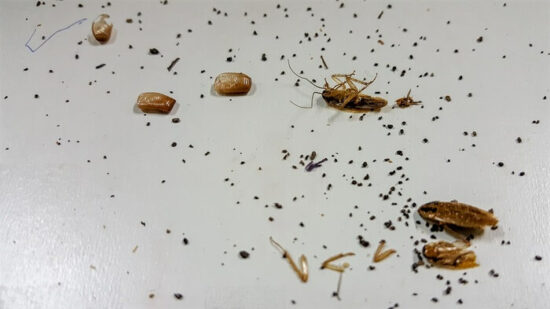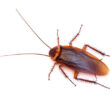“What does cockroach poop look like?” is a question we get from concerned homeowners all the time. And it makes complete sense. You need to know what you’re looking at before you can determine if there’s a problem!
This guide will help you understand what cockroach droppings look like, and what you should do if you find some in your home.
Table of contents
What Does Cockroach Poop Look Like?
Cockroaches are an elusive pet species that likes to stay out of sight. These pests often invade homes under the cover of night, establishing a growing presence in the shadows. By the time many people notice they have a roach problem, the pest population is thriving!
While roaches are stealthy little creatures, they tend to leave behind one telltale sign of their presence: poop!
Roaches produce solid and semi-solid waste that professionals often refer to as “frass.” Interestingly enough, these bugs don’t urinate. Feces, as well as shed skin, are the primary indicators used to diagnose a pest problem.
So what does cockroach poop look like?
Cockroach poop can vary in appearance based on the size of the bug, its species, and the surface it left its droppings on. Smaller roach species, such as the brown-banded and German cockroach, tend to leave behind fine and delicate pellets.
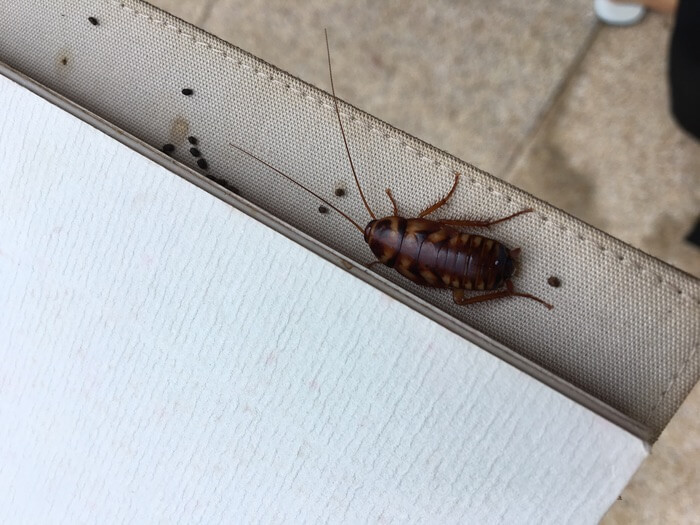
Their droppings are usually dark brown or black. As far as texture goes, the feces can look like coarse coffee grounds or flecks of black pepper. More moist droppings may even look like smears of dark brown or black ink drops.
Smaller cockroach droppings are much harder to find. However, they can appear in large groups if you have a severe infestation. In that case, the frass looks more like splotchy paint droplets.
Quick Tip: The same goes for the waste of baby roaches. Freshly hatched insects poop too! However, their droppings are so small that they’re usually undetectable unless they appear in massive groups.
If you’re dealing with bigger roaches like palmetto bugs or American cockroaches, the frass is much more noticeable.
Palmetto bug poop is larger and more akin to grains of rice. The poop is cylindrical and features rounded ends. If you look closely with a magnifying glass, you’ll also notice small ridges on the side of each piece.
Roach poop is quite distinct from other pest droppings. The ridges and rounded edges are unique identifiers, as those elements don’t appear on similarly sized rat droppings.
Where To Check
Cockroaches aren’t super keen on keeping things clean and hygienic. They’ll happily poop anywhere! However, there are a few places where defecation is most likely to happen.
Generally, roaches will leave droppings behind as they scavenge for food and water near their nesting place. You may find stray poop from bugs venturing farther than usual, but most of it will appear near food sources, nests, and areas of congregation.
Here are the most common places to look for roach droppings:
Hidden Nooks & Crannies
Roaches hide in corners and crevices you can’t see. Because of this, you might see frass in the corner of a room, along baseboards, or near any structural cracks and openings. Whether those cracks appear on the floor, ceiling, or wall, roaches will take advantage of them to navigate the home.
Dark Areas
Many homeowners also see cockroach droppings around spots that are regularly shielded from the light. For example, roaches might travel underneath appliances, on top of high shelves, behind picture frames, and over window casings.
Shelves, cupboards, and storage boxes are some of the worst offenders. It’s not uncommon to find roach droppings in your kitchen cabinets or any other dark area that’s close to food.
Food Sources
Cockroaches prefer to stay near organic food sources. That doesn’t just mean fresh food or crumbs. These insects like to snack on cardboard and paper as well! As a result, droppings often appear in pantries and food storage areas.
The worst place to find droppings is around food that you and your family eat. Unfortunately, it’s often the first place roaches flock to! If you leave food out overnight, don’t be surprised to find poop in the vicinity.
Quick Tip: Even places where you inadvertently track food can harbor roach waste. We’re talking about mattresses, children’s playpens, toy chests, and everywhere in between.
Roach droppings can appear anywhere that these bugs go. If there’s food nearby, these pests will follow and leave behind a nasty surprise!
How To Get Rid Of Cockroach Droppings
If you see cockroach droppings, don’t ignore them! Take it as a sign and be proactive about dealing with the infestation!
The first step is to clean the mess up.
To get rid of loose cockroach droppings, use a vacuum cleaner that’s equipped with a HEPA filter. The vacuum will make quick work of large messes and ensures that you don’t have to touch anything with your hands. Meanwhile, the HEPA filter will make sure that the poop doesn’t go airborne!
Make sure to dispose of the vacuum’s contents properly. It doesn’t hurt to sanitize the canister as well.
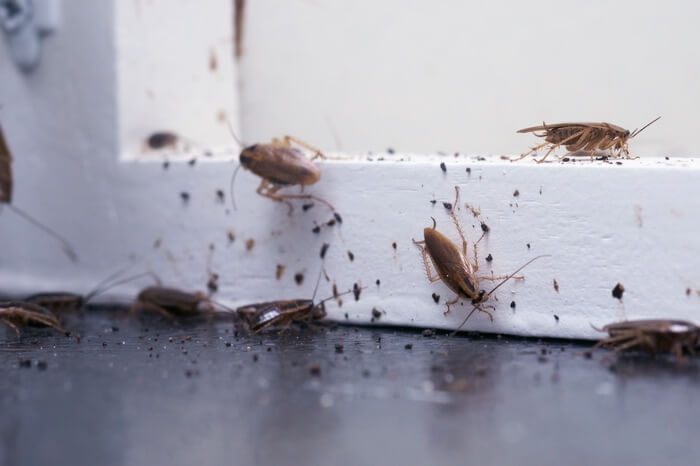
Next, your goal should be to sanitize the area. Poop can quickly spread harmful bacteria and disease. Assume that the site you found the frass in is filthy, and do your best to disinfect it.
If you found the droppings on a smooth surface, use a liquid-based cleaner. Simple soap and hot water work best. However, bleach-based cleaners or disinfectants are even better.
Those cleaners will kill bacteria and remove any odors that the poop leaves behind. More on that soon!
Use your chosen cleaning product to remove any stains and smears if they are present.
Now, if you find roach droppings on a soft surface, you’ll need to work a little harder to clean things thoroughly.
For carpets, start with a deep vacuum cleaning. Some poop tends to fall between the fibers where you can’t see it. Vacuuming picks all of the remnants up.
Next, use a carpet shampoo. Most shampoo products have beneficial enzymes that can break down things like poop and urine. Let the solution work its magic before drying and vacuuming again.
You can use the same cleaning method for mattresses, couches, and other soft surfaces. If carpet shampoo isn’t available to you, soap and water work well also. Use a brush to work the solution into the upholstery for a deeper clean.
Quick Tip: Loose fabrics like blankets or clothes will require a complete cycle in your washing machine. If possible, use a disinfecting detergent to make sure that the materials get as clean as possible.
Does It Smell?
You might think that a few cockroach droppings wouldn’t be enough to make a noticeable smell. But you’d be wrong!
Like any other poop, roach waste does have an unpleasant odor. It might not be overwhelming in small quantities, but larger infestations can make the smell unbearable!
Roach poop smells acrid and somewhat oily. It’s a musty aroma that can seep into just about anything. If you leave the poop behind, the smell will only get worse with time.
But that’s not the worst part. The smell of cockroach poop is about so much more than unpleasantries. It’s a natural pest attractor!
Frass has pheromones that call other roaches to come. It’s like an invisible way to communicate. Cockroaches in an entirely different part of your home will pick up the pheromones and assume that the area is safe for the congregation.
Before you know it, an entire flock of roaches will visit the same place in search of mates or food. That’s why you often see a lot of roach poop together!
Cleaning up the mess with sanitization products will help to eliminate the smell. But more importantly, it’ll get rid of the attractant pheromones.
Can It Make You Sick?
There’s no denying that finding roach poop in your home is pretty gross. The sight of the stuff is enough to scare people into thinking that there’s an active infestation. But does poop actually do any harm?
To put it simply, yes.
Roach poop is a byproduct of the things these insects eat. That means it can contain everything from garbage to dead animals and other insects. Plus, there’s the matter of bacteria and disease.
Cockroaches are often seen as a relatively harmless pest that stays out of sight and out of mind. While that may be true, the poop they leave behind can be a source of disease for you and your family!
Here’s why:
First off, the poop itself contains allergens. Waste and shed skin contain proteins that are known to trigger reactions in humans. Those with asthma have it the worst, as breathing those proteins in can prompt attacks.
Quick Tip: Some experts believe that roach poop can even cause young kids to develop asthma over time!
As if that weren’t bad enough, touching the poop with bare skin can also cause some issues. Thanks to the small size and discrete nature of roach poop, it’s not uncommon for people to accidentally step in it. This often leads to skin irritation and allergic reactions.
Now, let’s consider the general filthy nature of a cockroach. These bugs aren’t inherently toxic, but they often harbor dangerous pathogens.
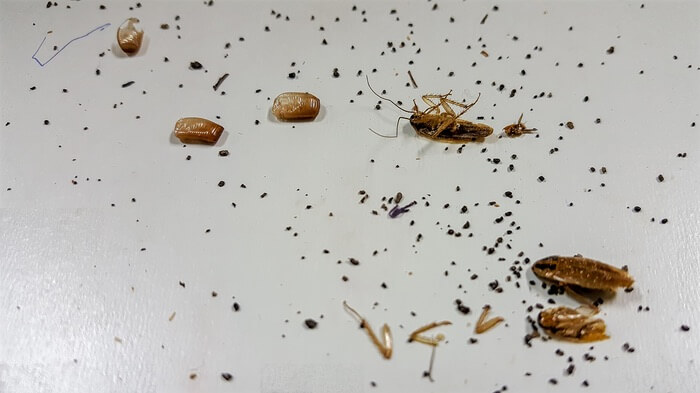
Cockroaches are known to spread roughly 33 different kinds of bacteria. These include six types of parasitic worms and seven types of human pathogens. The most dangerous? That would be E. coli and salmonella!
Roaches frequently poop around food sources. It’s not unheard of to accidentally eat roach feces. In fact, it’s more common than you think.
Inadvertently eating frass could lead to serious illness. You could suffer from gastroenteritis and experience a wide range of symptoms. In severe cases, bacterial diseases could infect your bloodstream and lead to life-threatening complications!
In other words, cockroach droppings are not something you want to take lightly.
Why You Should Look For Droppings Consistently
As you might imagine, it’s important to always keep an eye out for roach droppings.
Pest experts often recommend that homeowners do an active inspection regularly as part of their standard DIY pest control routine. Keep note of any problem areas and look for roach poop regularly.
If you spot frass, do your part to clean up the mess and control the pest population.
As mentioned earlier, roach poop harbors all kinds of potentially dangerous bacteria. Ignoring it only puts you and your family at risk.
Viruses and pathogens are no joke. These bugs are prime carriers of bacteria that can make you sick and cause life-changing diseases. That’s not something you want to risk.
Another significant issue is the risk of attracting more bugs. The natural pheromones can bring more bugs into the mix. Even those living outside may get a whiff of the natural aroma and make their way into your home.
Quick Tip: Roaches proliferate relatively fast on their own. Populations can quickly get out of hand if you ignore droppings.
Roaches can defecate anywhere. It’s not uncommon to find droppings on food, in bathrooms, or even in beds (which is why it’s important to know how to keep cockroaches away at night). The waste can appear where you least expect it, so it’s crucial to examine your entire home from top to bottom.
To make matters worse, droppings stick around for a long time. The feces will slowly decay with time. But until that happens, it continues to pose a health and safety risk for anyone in the home.
Look for cockroach poop consistently. We recommend doing a detailed inspection at least once a month. If possible, aim for even more frequent examinations.
Finding and removing roach poop will do a lot to keep your home safe and healthy. But more importantly, it helps you stay on top of the roach problem at large. Understanding the size and location of the population will give you the tools to eradicate it completely.
Wrapping Up
Knowing what roach droppings look like is valuable knowledge. It will allow you to quickly diagnose a potential infestation and take the appropriate action to keep your house cockroach-free.
If you have any questions or feel that you have a serious infestation on your hands, we highly recommend taking things to the next level and talking with an exterminator in your area.
